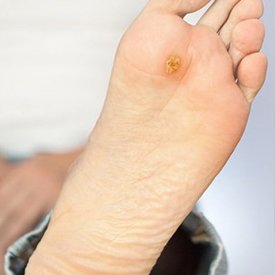Diabetic Foot
 The removal of devitalized tissue to control infection and creation of an environment favorable for healing, while maximizing the structural and physical integrity of the foot, is the central goal of surgical intervention in treating diabetic foot infections.
The removal of devitalized tissue to control infection and creation of an environment favorable for healing, while maximizing the structural and physical integrity of the foot, is the central goal of surgical intervention in treating diabetic foot infections.
Surgical procedures span a range from simple outpatient debridements to guillotine amputations in diabetics with life-threatening infections.
Abscesses of the foot or toes are best approached through lateral incisions that avoid weight-bearing surfaces. Diamond shaped incisions in the plantar or dorsal surfaces are used to drain the web space. Sadly, infections arising in this area frequently extended into the central compartment of the foot and mandate more extensive debridement. Neuropathic ulcers and their associated calluses should be sharply debrided to facilitate healing, since debridement alone has been shown to positively affect healing . Osteomyelitis frequently results from direct extension to bone from a neuropathic ulcer and is more effectively treated by surgical resection than antibiotics alone . The surgical treatment of neuropathic ulcers has been shown to reduce healing time and decrease infectious complications when compared to non-operative management. Elective foot surgery in diabetics carries only a modest increased risk of infection and may prevent the development of more serious infectious sequelae such as amputations. Amputations for diabetic foot infections should not follow the classic textbook descriptions, rather they should be limited to removing all necrotic, devitalized tissue and bone while sparing as much skin and tissue as possible. Arterial reconstructive surgery is an important adjunct to therapy and may be required to heal an amputation or non-healing ulcer, in patients with documented vascular disease. Arterial bypass surgery to the pedal vessels has reduced the incidence of lower extremity amputations for diabetic foot infections , nonetheless the percentage of amputees who are diabetic remains disproportionately high. Attempts to reduce the incidence of lower extremity amputations has shown that multi-disciplinary team management, with emphasis on preventative measures, is one of the more effective means of accomplishing this goal
